Thailand
Recipes
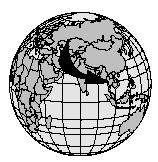
1 GEOGRAPHIC SETTING AND ENVIRONMENT
Comprising an area of 514,000 square kilometers (198,456 square miles) in Southeast Asia, Thailand (formerly known as Siam) extends almost two-thirds down the Malay Peninsula. Comparatively, the area occupied by Thailand is slightly more than twice the size of the state of Wyoming.
Thailand may be divided into five major physical regions: the central valley, fronting the Gulf of Thailand; the continental highlands of the north and northwest, containing Thailand's highest point, Doi Inthanon (2,565 meters/8,415 feet); the northeast, much of it often called the Khorat Plateau; the small southeast coastal region facing the Gulf of Thailand; and the Malay Peninsula, extending almost 960 kilometers (600 miles) from the central valley in the north to the boundary of Malaysia in the south.
Thailand has a tropical climate. In most of the country, the temperature rarely falls below 13°C (55°F) or rises above 35°C (95°F).
2 HISTORY AND FOOD
Until 1939, the country we call Thailand was known as Siam. It was the only Southeast Asian country never colonized by the West. This helped Thailand to maintain its own special cuisine (cooking style). However, that cuisine had already been influenced by Thailand's Asian neighbors.
The Thai (pronounced TIE) people migrated to their present homeland from southern China about 2,000 years ago. They brought with them the spicy cooking of their native Yunan province, as well as its dietary staple, rice. Other Chinese influences on Thai cooking included the use of noodles, dumplings, soy sauce, and other soy products. Like the Chinese, the Thais based their recipes on blending five basic flavors: salty, sweet, sour, bitter, and hot.
From nearby India came not only the Buddhist religion, but also spicy seasonings such as cumin, cardamom, and coriander, as well as curry dishes. The Malays, to the south, further shared seasonings, as well as their love of coconuts and the satay (a dish that is similar to shish kebabs). Since 1970, Thai cooking has become extremely popular in both North America and Britain.
3 FOODS OF THE THAIS
Rice is the main dietary staple of Thailand. Thais eat two kinds of rice: the standard white kind and glutinous, or sticky, rice. Sticky rice rolled into a ball is the main rice eaten in northeastern Thailand. It is also used in desserts throughout the country. Rice is eaten at almost every meal and also made into flour used in noodles, dumplings, and desserts. Most main dishes use beef, chicken, pork, or seafood, but the Thais also eat vegetarian dishes.
Thai food is known for its unique combinations of seasoning. Although it is hot and spicy, Thai cooking is carefully balanced to bring out all the different flavors in a dish. Curries (dishes made with a spicy powder called curry) are a mainstay of Thai cooking. Hot chilies appear in many Thai dishes. Other common flavorings are fish sauce, dried shrimp paste, lemon grass, and the spices coriander, basil, garlic, ginger, cumin, cardamom, and cinnamon. Soup, eaten with most meals, helps balance the hot flavors of many Thai dishes as do steamed rice, mild noodle dishes, and sweet
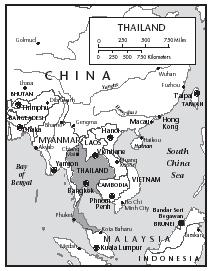
Coconuts play an important role in the Thai diet. Coconut milk and shredded coconut are used in many dishes, especially desserts. Thais eat a variety of tropical fruits for dessert, including mangoes, papayas, custard apples with scaly green skins, and jackfruit, which is large and prickly and has yellow flesh.
Thai food differs somewhat from one region to another. Seafood is popular in the southern coastal areas. The Muslims in that part of the country favor curries. The spiciest food is found in the northeast.
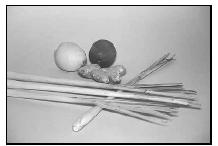
Nam Pla Prig (Dipping Sauce)
This sauce is used as a dip. It is provided on the table at every Thai meal, in the same way that salt and pepper are provided on most tables in North America.
Ingredients
- 2 cloves garlic
- 1 teaspoon crushed red pepper flakes
- 4 Tablespoons sugar
- 2 Tablespoons fresh lime or lemon juice
- 4 Tablespoons fish sauce (available at supermarkets and Asian food stores)
- 2 Tablespoons water
Procedure
- Combine all ingredients in a small bowl.
- Stir to dissolve sugar.
- If sauce is too salty, add more water.
- Serve at room temperature in individual bowls.
- Keeps for up to 2 weeks in the refrigerator, tightly covered.
Thai Beef Curry
Ingredients
- 10 ounces beef flank steak with the fat trimmed off
- 2 cups coconut milk, unsweetened
- 2 Tablespoons red curry paste
- 1 teaspoon fish sauce
- 1 cup bamboo shoot strips
- 1 teaspoon sugar
- 3 Tablespoons water
- 20 leaves of fresh basil
- ¼ medium red pepper, cut into thin strips
- 2 Tablespoons green peas, frozen
- 2½ cups rice, steamed
Procedure
- Slice the steak into pieces ¼-inch thick, 2 inches long, and about 1-inch wide.
- Heat 1 cup of the coconut milk in a wok or frying pan and add the red curry paste.
- Stir to dissolve and cook at high heat for 5 to 6 minutes, until the oil of the coconut milk rises to the top and the sauce thickens.
- Add fish sauce and stir it in.
- Add the second cup of coconut milk and the beef. Reduce heat to medium.
- Add the bamboo shoot strips and the sugar. Return the heat to high and add 3 Tablespoons water.
- Cook, stirring for 3 minutes until bubbling.
- Add ¾ of the basil leaves, the red pepper strips and the green peas.
- Stir and cook for another 30 seconds, folding all the ingredients into the sauce.
- Remove from heat and transfer to a serving dish.
- Top with the rest of the basil leaves and the additional red pepper strips.
- Serve immediately, accompanied by steamed rice.
Serves 8.
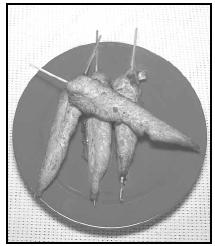
Chicken Satay
Ingredients
- 1 pound skinless, boneless chicken breast
- 1 teaspoon black pepper
- 1 teaspoon ground cumin
- 1 teaspoon ground coriander
- ½ teaspoon turmeric
- 1 teaspoon chopped garlic
- 1 Tablespoon sugar
- 1 Tablespoon vegetable oil
- 1 Tablespoon soy sauce
- 1 Tablespoon lemon juice
- 1 teaspoon fish sauce
- Small amount of oil or coconut milk
- Fresh coriander leaves
- Lettuce leaves
Procedure
- Slice chicken breasts into thin slices lengthwise. Each slice should be about 4 inches by 1 inch by ¼ inch. (Optional: place chicken in freezer for 15 to 20 minutes to make it easier to slice.) Place the chicken strips in a mixing bowl.
- Add remaining ingredients, first the solids, then the liquids, to the bowl. Toss until well mixed.
- Let the chicken marinate (absorb the flavoring) in the refrigerator for at least 2 hours and as long as 24 hours.
- When ready to cook the satay, stir the chicken in the sauce and remove.
- Thread each slice onto a skewer, pushing the skewer in and out down the middle of the slice.
- Baste (rub) the chicken with oil or coconut milk and grill on a barbecue or under the broiler.
- Cook for about 2 minutes on each side, watching carefully and turning to keep the chicken from burning.
- Baste once more with oil or coconut milk. The satay is done when it's golden brown and crispy along the edges. Serve with optional garnish with fresh coriander leaves.
Serves 8.
Cucumber Salad
Ingredients
- 1 long cucumber
- ½ small red onion
- ⅓ medium red pepper
- 1 Tablespoon sugar
- Vinegar
- ½ teaspoon salt
- Fresh coriander leaves
Procedure
- Wash and dry the cucumber, and peel it if desired.
- Cut in half lengthwise and then into quarters.
- Slice the quarters into ¼-inch pieces and arrange on a plate.
- Slice the red pepper and onion into thin strips. Scatter them over the cucumber.
- In a small bowl, combine the sugar, vinegar, and salt.
- Pour dressing over the vegetables and top with the coriander leaves.
Serves 4 to 6.
4 FOOD FOR RELIGIOUS AND HOLIDAY CELEBRATIONS
Although most Thais are Buddhists, there are no food taboos in Thailand. The Thais celebrate a number of seasonal festivals and Buddhist holidays with feasts and banquets. Some of the foods eaten at these meals have a symbolic meaning. Among these are "golden threads," a thin layer of egg or noodles wrapped around small pieces of food. It is thought that they bring good luck and wealth to the person who eats them. Like the Chinese, the Thais believe that long noodles symbolize long life. Grilled, baked, or fried chicken is a popular food for holiday banquets. While everyday meals end with fruit, sweet desserts are served on special occasions. These fall into two categories: cakes ( kanom ) and liquid desserts, such as bananas and coconut milk.
One of the most important feast days is Songkran, the traditional Thai New Year, celebrated in April. People throw buckets of water at each other to let everyone start fresh for the coming year. Egg rolls are traditionally eaten for Songkran, as well as other holidays. Custard is another traditional dish served on Songkran.
Poa Pee (Thai Egg Rolls)
Ingredients
- 3½ ounces (one-half package) rice noodles or cellophane noodles
- ½ pound ground pork
- ½ pound ground beef
- 1 cup carrots, peeled and shredded
- 1 cup bean sprouts or shredded cabbage
- ½ medium onion, chopped
- 1 Tablespoon fish sauce
- ¼ Tablespoon pepper
- ½ clove garlic, finely chopped
- 1 teaspoon sugar
- 1 package of lumpia papers (rice-paper wrappers may be substituted; both are sold in gourmet or frozen foods section of supermarket or Asian grocery store)
- ½ cup vegetable oil
- 3 black mushrooms (optional; sold in Asian grocery stores and some supermarkets and gourmet stores)
- 1 egg
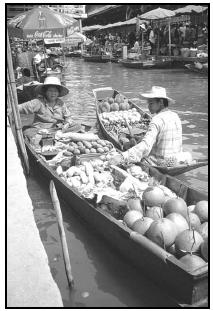
Procedure
- If using black mushrooms, soak them in hot water for 15 minutes. Drain well in a strainer.
- Discard mushroom stems and shred caps.
- Soak noodles in hot water according to package directions. When soft, drain and cut into 2-inch pieces with a sharp knife or scissors.
- In a large bowl, beat egg well. Add black mushrooms, noodles, pork, beef, carrots, bean sprouts, onion, fish sauce, pepper, garlic, and sugar. Mix well.
- Place 1 wrapper on a flat surface. Cover remaining wrappers with a slightly damp kitchen towel so they don't dry out.
- Place about 1½ Tablespoons of filling just below the center of each wrapper and fold up into a roll. Press edges to seal.
- In a large skillet or wok, heat oil over medium heat for 1 minute.
- Carefully place 3 rolls in oil and fry slowly for about 10 minutes or until golden brown. Turn and fry the other side 10 minutes.
- Keep fried rolls warm in oven heated to 200°F.
- Serve hot with individual bowls of nam pla prig or with sweet-and-sour sauce.
Sang Ka Ya (Thai Coconut Custard)
Ingredients
- 4 eggs
- ¼ cup brown sugar
- ¼ cup white sugar
- 1 cup coconut milk
- 1 cup winter squash, thinly sliced with seeds and rind removed
Procedure
- In a deep bowl, beat eggs well.
- Add brown and white sugars and stir until dissolved.
- Add coconut milk and squash and stir well.
- Pour mixture into a 9- by 9-inch baking pan or a 9- or 10-inch pie pan.
- Place ½ cup water into a steamer or Dutch oven large enough to hold the custard pan.
- Bring water to a boil over high heat, and place pan with custard inside.
- Cover and steam over high heat for 30 minutes.
- Serve at room temperature.
Serves 12.
Banana with Coconut Milk
Ingredients
- 12 half-ripe bananas
- 4 cups fresh or canned coconut milk
- ¼ cup sugar
- ⅛ teaspoon salt
Procedure
- Peel the bananas and cut in quarters. Place in a steamer over boiling water. Steam for 20 minutes; set aside.
- In a large pot heat the coconut milk, sugar, and salt on high heat. As soon as it boils, add the bananas.
- Reduce heat and simmer for 1 hour.
- Serve hot.
Serves 8 to 12.
5 MEALTIME CUSTOMS
Thais are famous for their love of snacks. There are food stalls near every public place due to the Thai habit of snacking all day. These stalls sell hundreds of different snacks. Among the most popular are fish cakes, egg rolls, fried rice, and noodles served with a choice of seasonings.
Thais eat three meals daily, plus many snacks. Dinner is the main meal. Breakfast often consists of fried rice, boiled eggs, and foods left over from the previous day's dinner. Lunch is usually a single-dish meal based on either rice or noodles. The main meal, eaten at dinnertime, consists of several different dishes chosen to balance different flavors and cooking methods. Soups are served with most main meals and are sipped throughout the meal. A typical dinner is steamed rice, a curry dish, a vegetable dish, a cold salad, and soup. Rice is the only food placed on each person's plate. All the other dishes are brought to the table in serving bowls, and people help themselves. Fresh fruit is served at the end.
Unlike their Asian neighbors, Thais do not use chopsticks unless they are eating noodles. Most of the time they use a fork and a flat-bottomed spoon. The fork is used only to push food onto the spoon, not to bring it to one's mouth. Food is already cut into bite-sized pieces, so a knife is not needed.
Holiday Menu
Poa Pee (egg roll)
Spicy beef salad with lemongrass sauce
Spicy mint noodles
Chicken with basil
Sang Ka Ya (custard)
Thais like their food to please the eye as well as the taste buds . They carve fresh fruits and vegetables into fancy shapes and serve prepared foods in pretty containers.
Ka Nom Jeen Sour Nam (Pineapple Fish Noodles)
Ingredients
- 3 Tablespoons vegetable oil
- 2 pounds fish fillets, cut into bite-size pieces
- 1 clove garlic, finely chopped
- 1 teaspoon fresh ginger, finely chopped
- 1 can (20-ounces) crushed pineapple, drained thoroughly
- 1 cup coconut milk
- 2 teaspoons fish sauce
- ⅛ teaspoon pepper
- 1 teaspoon sugar
- ⅛ teaspoon cayenne pepper
- Fresh mint and coriander for topping (optional)
Procedure
- In a large skillet or wok, heat oil over high heat for 1 minute.
- Add fish, garlic, and ginger.
- Cook, stirring constantly, for 3 minutes or until fish becomes white.
- Add pineapple, coconut milk, fish sauce, pepper, sugar, and cayenne pepper and stir well.
- Cook, stirring constantly, for 2 minutes or until fish flakes easily.
- Serve over hot rice noodles, topped with fresh mint and coriander.
Pad Thai
This is Thailand's most famous noodle dish.
Ingredients
- 12 ounces of Pad Thai noodles
- 8 cups cold water
- ¼ cup olive oil
- 1 Tablespoon garlic, chopped
- 16 medium shrimp, shelled and deveined (with the veins taken out)
- 2 ounces firm brown tofu, cut into ¼-inch cubes
- 2 eggs, beaten
- ¼ cup crushed unsalted peanuts
- 3 Tablespoons fish sauce
- 2½ Tablespoons rice vinegar
- 1 Tablespoon sugar or 1½ Tablespoons honey
- 2 teaspoons paprika
- ½ teaspoon crushed red pepper or cayenne pepper
- 3 ounces fresh bean sprouts
- ¼ cup leeks, cut into 1½ to 2-inch-long shreds
Procedure
- In a large bowl, soak noodles in cold water 45 minutes.
- Drain in a colander (special bowl with holes for draining) and set aside.
- Heat olive oil in a large skillet over high heat.
- Add garlic and sauté until lightly browned, about 1 minute.
- Add shrimp and tofu and sauté 1 minute.
- Add eggs and stir 30 seconds.
- Add noodles, peanuts, fish sauce, vinegar, sugar, paprika, and red pepper and stir constantly for 3 minutes.
- Remove from heat and transfer to a platter. Sprinkle with bean sprouts and leeks and serve.
Serves 8 to 10.
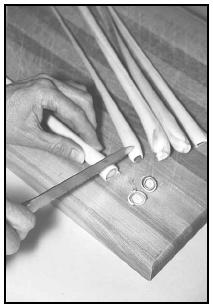
Coconut-Chicken Soup
Ingredients
- 14 ounces skinless, boneless chicken breast
- 1 stick lemon grass
- 1 inch ginger root
- 1 Tablespoon lime juice
- 2 fresh hot chilies
- 2 cups unsweetened coconut milk
- 1 cup water
- 2 Tablespoons lemon juice
- 1 Tablespoon fish sauce
- ¼ teaspoon sugar
- Fresh coriander leaves
Procedure
- Slice chicken into thin strips.
- Smash the lemon grass once with a rolling pin. Cut it into 1-inch slices.
- Cut the ginger into thin slices and cut the chilies in half.
- Heat coconut milk and water in a saucepan for 2 to 3 minutes over medium heat. (Do not let it boil.)
- Add the lemon grass, ginger, and chilies, and cook for another 2 minutes, stirring continuously and not letting the liquid boil.
- Add chicken strips and cook for 5 minutes, stirring over medium heat, until the chicken is cooked. Lower heat if mixture starts to boil.
- Add lemon juice, lime juice, fish sauce, and sugar.
- Stir and continue cooking for another minute or two.
- Pour soup into a serving pot and serve immediately, topped with fresh coriander leaves.
Serves 6 to 8.
6 POLITICS, ECONOMICS, AND NUTRITION
About 24 percent of the population of Thailand is classified as undernourished by the World Bank. This means they do not receive adequate nutrition in their diet. Almost all of the population (94 percent) has adequate access to sanitation. Of children under the age of five, about one-quarter are underweight, and nearly 22 percent are stunted (short for their age).
Despite malnourishment, Thailand is the world's largest rice exporter, accounting for over 22 percent of all agricultural exports by value in 1997. It also provides about 95 percent of the world's cassava (tapioca) exports. The government, however, has initiated large-scale irrigation projects, introduced higher-yielding varieties of rice, and encouraged mountain villagers to grow coffee, apples, strawberries, and other crops in an effort to increase exports and compete in the global market.
7 FURTHER STUDY
Books
Bremzen, Anya von, and John Welchman. Terrific Pacific Cookbook. New York: Workman Publishing, 1995.
Davidson, Alan. The Oxford Companion to Food. Oxford: Oxford University Press, 1999.
Halvorsen, Francine. Eating Around the World in Your Neighborhood. John Wiley & Sons: New York, 1998.
Harrison, Supenn, and Judy Monroe. Cooking the Thai Way. Minneapolis: Lerner Publications, 1986.
Rutherford, Scott, ed. Insight Guide Thailand. Singapore: APA Publications, 1998.
Sananikone, Keo. Keo's Thai Cuisine. Berkeley: Ten Speed Press, 1986.
Webb, Lois Sinaiko. Holidays of the World Cookbook for Students. Phoenix: Oryx Press, 1995.
Young, Wandee, and Byron Ayanoglu. Simply Thai Cooking. Toronto: Robert Rose, 1996.
Web Sites
Asia Foods. [Online] Available http://www.asiafoods.com (accessed February 7, 2001).
Bangkok Cuisine. [Online] Available http://bangkokcuisine.com/original/bangkok/recipes.htm (accessed July 19, 2001).
Epicurious. [Online] Available http://epicurious.com (accessed February 7, 2001).
SOAR (online recipe archive). [Online] Available http://soar.Berkeley.edu (accessed February 7, 2001).
Mail-order and online sources for specialty ingredients:
The Oriental Pantry
423 Great Road (2A)
Acton, MA 01720
(978) 264-4576
[Online] Available
http://www.orientalpantry.com
(accessed February 7, 2001).